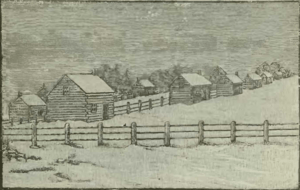Credit Mission facts for kids
The Credit Mission was a special community built for Indigenous people, specifically the Mississaugas of the Credit, near the Credit River in what was then called Upper Canada (now part of Ontario, Canada). It was a place where they could live, learn, and practice their Christian faith, particularly Methodism.
Building a New Home
Building the Credit Mission started in 1826. The money for this project came from land sales, specifically from a deal known as Purchase #22 or #23. A very important leader named Peter Jones helped guide the construction.
When the work began, about 200 Mississaugas were already living in the area in temporary shelters. The plan was to build a permanent village for them. Workers built thirty sturdy log cabins on about 200 acres (0.81 km2) of land set aside for the community.
That same year, Egerton Ryerson joined the mission as a Methodist missionary. Soon, a Methodist church was built, which became a central part of the community. A school was also constructed, and John Jones became its first teacher. In the spring of 1827, the community planted about 40 acres (160,000 m2) of land with important crops like corn and potatoes. This helped the community become more self-sufficient.
Changes in Leadership
In 1829, a sad event occurred when one of the three chiefs of the Mississaugas, John Cameron, passed away. To fill his important role, Peter Jones was chosen and elected as a chief. This showed how much the community trusted and respected him.
A year later, in 1830, John Jones, the first schoolteacher, had to retire from his position. He was suffering from Tuberculosis, a serious illness at the time.
Later, in 1840, John Jones was again elected as one of the three chiefs of the Credit band. This shows his continued importance to his people.
Challenges and Moving On
In 1836, a government official named Lieutenant Governor Francis Bond Head visited the Credit Mission. He was very impressed, calling it the "cleanest, neatest and most civilised of all the Indian settlements he had seen."
However, relations between the provincial government and the Mississaugas began to get difficult. The government wanted the Mississaugas to switch from Methodism to Anglicanism, but the community strongly wanted to keep their Methodist faith.
During the 1830s, Lieutenant Governor Sir Francis Bond Head started making plans to move the Mississaugas of the Credit Mission. He wanted them to relocate to Manitoulin Island, which is far away. Chief Peter Jones understood that this move would be very bad for his people. Manitoulin Island was too rocky for farming, and moving there would force them to go back to a hunter-gatherer way of life, making it hard to survive.
To prevent this move, Chief Peter Jones traveled all the way to England. There, he met with important leaders like Colonial Secretary Lord Glenelg and even Queen Victoria herself. He explained the problems with Bond Head's plan. The Colonial Office in England agreed with Peter Jones and stopped Bond Head's plan.
Even though the Queen authorized that the Mississaugas should receive the official title deeds to their land, they never actually got them. This meant they remained vulnerable to other settlers moving onto their land.
Finally, in 1847, because they could not get the legal land rights to the mission, the Mississaugas of the Credit Mission decided to move. They relocated to a new place called New Credit. The land for this new home was generously donated by the Six Nations.


